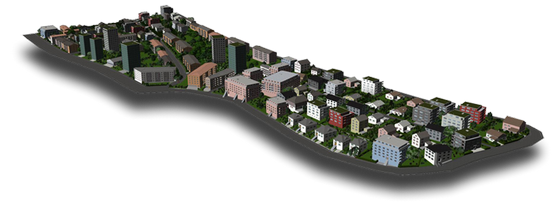Visualization Types
Realistic renderings and animations
Changes of the visual landscape can affect these services. Realistic renderings and animations of possible future scenic views help to assess the potential impacts and support pro-active spatial planning.
Preferences of stakeholders and the public regarding alternative development options and the valuation of various landscape services are increasingly investigated using cost-benefit analyses. Integrating 3D landscape visualizations of the landscape development options into these experiments makes an assessment of the view of the landscape possible, which is a significant landscape factor. But even more important, it reduces the error rate of these analyses. Our research addresses the enhancement of these experiments with 3D visualizations.
Interactive virtual 3D models
Interactive virtual 3D models offer many functions that help to overcome theoretical threats concerning validity of these visualization tools in decision-making contexts. The use of interactive landscape models instead of fixed, static and limited images for scenic beauty judgements allow to assess the whole scene in its overall context. Dynamic modelling systems can show landscape change over time or dynamic thresholds. Further, they provide greater access to and transparency of visual imagery and underlying metadata than still images.
Ongoing research focuses on application and valuation of the still advancing interactive visualization technology in supporting real-world decision-making processes. Results will contribute to intermediate principles and standards ensuring ethical use of this technology.
Procedural landscape and urban modeling
Innovative procedural modelling methods for the automatic creation of large-scale 3D city models offer unprecedented opportunities to understand and encode urban patterns. They allow to easily produce multiple design alternatives based on design rules leading the simulation procedure. While grammars shaping the urban environment have already been defined, the contribution of the natural environment to urban qualities has not yet been encoded and integrated into a procedural modelling approach for sustainable city planning.
We explore the use of shape grammar driven procedural models for effectively linking natural resource indicators into the urban design process. We are working on an approach providing a starting point for more comprehensive, sustainable urban planning, and a useful tool for better informed and participatory decision-making.

